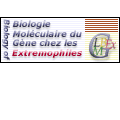
|
|















|
International Summer School
From Genome to Life:
Structural, Functional and Evolutionary approaches
CADORET Jean-Charles |
|
ENS/CNRS UMR8543 Organismes Photosynthétiques et Environnement, 46, Rue d'Ulm, Paris 75005, France title: Signal tranduction by cyclic nucleotides in cyanobacteria upon environmental changes Cyanobacteria can sense and adapt to a large variety of environmental changes but, at present, cyclic nucleotides is known about the molecular mechanisms that they have developed. Cyclic nucleotides (cAMP and cGMP) play a key role in signal tranduction both in prokaryotes and eukaryotes. Cyanobacteria posses both type of cyclic nucleotides and their concentrations fluctuate depending on nutriment and oxygen availability, as well as on light conditions. Complete genome sequences are already available for five cyanobacterial strains and a few more will soon be released; We have undertaken a functional genomic approach to unravel the signal transduction network in which cyclic nucleotides are involved. No bacterial type phosphodiesterase could be identified in the genome of the unicellular cyanobacterium Synechocystis sp. PCC6803. Putative proteins carrying phosphohdrolase domains (HD) are being characterized : genes were cloned and inactived, and the phenotype analysed using micro- and macroarrays, as well as biochemical and biophysical technology (spectrofluorimeter, fluorescence kinetic, and O2 evolution). Preliminary data suggest that indeed cAMP concentration and light adaptation are modified in mutant strains. The proteins were also overexpressed in Escherichia coli to in vitro ascertain their biochemical function. By comparing transcriptomes of wild type and mutant strains, we ara analysing the global changes induced by the mutations and changes in the environmental parameters. In addition, we are comparing the available cyanobacterial genomes to identify the common regulatory elements and the related to the physiological properties and ecological niches specific of each strain. |